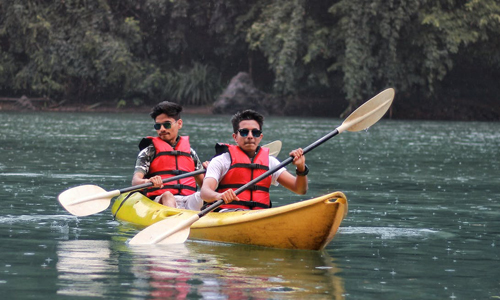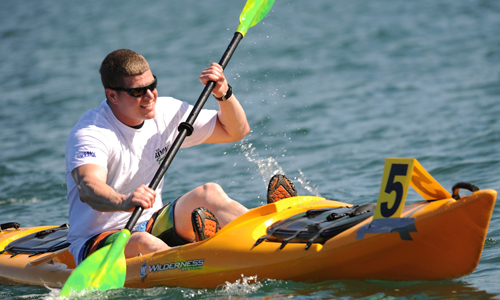An Insight to Recreational Kayaking
Author

Chris shares his passion for cycling, hiking, skiing, and climbing from Buxton, in the Peak District. As a blogger for Outdoor Look, Chris shares outdoor tips and indoor tricks to help you get the most out of your time spent outside. When he's not out adventuring he's making videos or trying to keep up with his 4-year-old son.
For those who like outdoor water sports, kayaking would be a great choice as it involves adrenaline pumping activity which many times in dangerous waters which takes the adventure level a notch higher. For beginners, recreational kayaking in calm and stable waters is the best thing to go about before they wade through the whitewater rapids and the sea.
What Does a Recreational Kayaker Need?
Find a Suitable Kayak
Choosing the right kind of kayak is really important so you are able to learn the skills in the right and safe manner. For beginners, it is the safest to use a recreational kayak. These are highly stable and easy to control kayaks that come at an affordable price. A recreational kayak is 9 to 12 feet long and has a wide cockpit which makes it easy for a kayaker to get in and out.
Moreover, you can use a sit-on-top kayak which is similar to a recreational kayak but has shallow impressions in its top instead of a cockpit. This one is among the most basic ones that are safest for the beginners to use.

Select the Right Paddle
You need the right kind of paddle to learn different techniques of paddling in recreational kayaking. An average paddle is 210-220cm long from one end to the other. For those who like to go fast or have heavy-hands, a short paddle would be an appropriate choice.
Paddles that cost less have a straight shaft while the expensive ones have a bent shaft that is designed to put less pressure on the wrist.
High Quality Safety Gear
Safety is the primary thing that should be taken into consideration even before you get into the water with your kayak. The basic Safety gear includes a personal flotation device, float bags, and a bilge pump.
- Flotation Device: This is a type of life vest that is meant to protect you in case you fall out of the kayak. This gear covers the shoulders and the neck without inhibiting the movement of the arms.
- Blige Pump: This is a handheld device that is designed to pump out water from the kayak.
- Float Bags: These are bags filled with air meant to float the boat in water in case it overturns. However, some kayaks have these built into them.

Learning How to Paddle
Once everything is in place including the kayak, the paddle, and safety gear, you should start learning the different paddling techniques. You must start with the basic method that requires you to need to use the upper and lower body together in order to powerfully move the paddle through the water so that kayak is propelled in forward direction.
Use the torso to maintain the power position for each stroke to be consistent. Once you get a hang of it, the chances of you getting injured would be the least.
Finding the Right Place to Kayak
Canals, lakes, sea, rivers, and lochs are the most ideal waters for recreational kayakers. Those who love adventure can go for faster moving water in certain sections of a river or tidal waters. However, it is necessary that you get all the skills perfected before wadding into faster waters.
Keeping all these things into consideration would ensure a safe kayaking experience. Being persistent is the key to becoming a professional which opens you up for greater adventures in much wilder waters.
Author

Chris shares his passion for cycling, hiking, skiing, and climbing from Buxton, in the Peak District. As a blogger for Outdoor Look, Chris shares outdoor tips and indoor tricks to help you get the most out of your time spent outside. When he's not out adventuring he's making videos or trying to keep up with his 4-year-old son.
- Speed Up Your Post-Hike Recovery with These 6 Essential Tips
- Cycling through Tranquil Roads and Coastal Views on the Isle of Wight
- The Essential Guide to Hiking Safety: 5 Tips Every Hiker Should Know
- Run Smart, Run Strong: Your Guide to Injury-Free Running
- Embrace Biking: Essential Tips for Beginners
Categories
- Sport (28)
- Product Reviews (3)
- Team Outdoor Look (7)
- Mike Wild (2)
- Mike Payton (2)
- Suse Hammond-Pears (3)
- Snowboarding (12)
- Latest Offers (105)
- Shop Talk (1)
- Competitions (7)
- Walking (413)
- Lifestyle Fashion (8)
- Travel (86)
- Kit Guides (176)
- Workwear Clothing (6)
- Safety Workwear (4)
- Health/Fitness (289)
- Skiing (91)
- Great Outdoors (1316)
- Cycling (92)
- January 2025
- December 2024
- November 2024
- October 2024
- September 2024
- August 2024
- July 2024
- June 2024
- May 2024
- April 2024
- March 2024
- February 2024
- January 2024
- December 2023
- November 2023
- October 2023
- September 2023
- August 2023
- July 2023
- June 2023
- May 2023
- April 2023
- March 2023
- February 2023
- January 2023
- December 2022
- November 2022
- October 2022
- September 2022
- August 2022
- July 2022
- June 2022
- May 2022
- April 2022
- March 2022
- February 2022
- January 2022
- December 2021
- November 2021
- October 2021
- September 2021
- August 2021
- July 2021
- June 2021
- May 2021
- April 2021
- March 2021
- February 2021
- January 2021
- December 2020
- November 2020
- October 2020
- September 2020
- August 2020
- July 2020
- June 2020
- May 2020
- April 2020
- March 2020
- February 2020
- January 2020
- December 2019
- November 2019
- October 2019
- September 2019
- August 2019
- July 2019
- June 2019
- May 2019
- April 2019
- March 2019
- February 2019
- January 2019
- December 2018
- November 2018
- October 2018
- September 2018
- August 2018
- July 2018
- June 2018
- May 2018
- April 2018
- March 2018
- February 2018
- January 2018
- December 2017
- November 2017
- October 2017
- September 2017
- August 2017
- July 2017
- June 2017
- May 2017
- April 2017
- March 2017
- February 2017
- January 2017
- December 2016
- November 2016
- October 2016
- September 2016
- August 2016
- July 2016
- June 2016
- May 2016
- April 2016
- March 2016
- February 2016
- January 2016
- December 2015
- November 2015
- October 2015
- September 2015
- August 2015
- July 2015
- June 2015
- May 2015
- April 2015
- March 2015
- February 2015
- January 2015
- December 2014
- November 2014
- October 2014
- September 2014
- August 2014
- July 2014
- June 2014
- May 2014
- April 2014
- March 2014
- February 2014
- January 2014
- December 2013
- November 2013
- October 2013
- September 2013
- August 2013
- July 2013
- June 2013
- May 2013
- April 2013
- March 2013
- February 2013
- January 2013
- December 2012
- November 2012
- October 2012
- September 2012
- August 2012
- July 2012
- June 2012
- May 2012
- April 2012
- March 2012
- February 2012
- January 2012
- December 2011
- November 2011
- October 2011
- September 2011
- August 2011
- May 2010
- April 2010
- March 2010
- February 2010
- January 2010
- November 2009
- October 2009
- September 2009
Submit a Comment